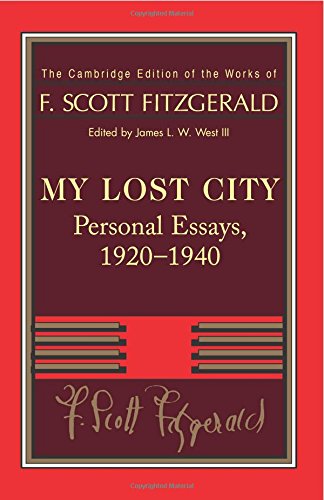Princeton is a Green Phoenix : F. Scott Fitzgerald
7th Mar 2020
F. Scott Fitzgerald is an icon of American literature. Fitzgerald attended Princeton, dropping out in 1917 to join the Army. In 1927 he wrote an essay about the University that he loved.

Fitzgerald: My Lost City: Personal Essays, 1920-1940 (The Cambridge Edition of the Works of F. Scott Fitzgerald) is a 340 page hardcover book, published in 2005. Twice during the last decade of his life, in 1934 and 1936, F. Scott Fitzgerald proposed a collection of his personal essays to Maxwell Perkins, his editor at Charles Scribner’s Sons. Perkins was unenthusiastic on both occasions and Fitzgerald dies in 1940 without having put his best essays between hard cover. Fortunately, Fitzgerald left behind a table of contents, and with this list as a guide it has been possible to publish this book the collection he envisioned.
The book includes a chapter on Princeton written in 1927. Fitzgerald writes, “Princeton is in the flat midlands of New Jersey, rising, a green Phoenix, out of the ugliest country in the world. Sordid Trenton sweats and festers a few miles south; northward are Elizabeth and the Erie Railroad and the suburban slums of New York; westward are the dreary upper purlieus of the Delaware River. But around Princeton, shielding her, is a ring of silence–certified milk dairies, great estates packed with peacocks and deer parks, pleasant farms and woodlands which we paced off and mapped down in the spring of 1917 in preparation for the war. The busy East has already dropped away when the branch line train rattles familiarly from the junction. Two tall spires and then suddenly all around you spreads out the loveliest riot of Gothic architecture in America, battlement linked on to battlement, hall to hall, arch-broken, vine-covered–luxuriant and lovely over two square miles of green grass. Hers is no monotony, no feel that it was all built yesterday at the whim of last week’s millionaire; Nassau Hall was already twenty years old when Hessian bullets pierced its sides.”
The Princeton chapter gives an interesting look at the pre-war University and its mores and traditions. He delves into the eating clubs and the admissions process, which is quite different than today’s.
The book is an undiscovered gem. Other chapters include his recollections of New York City, women and his philosophy of life. We have a nice selection of Princeton memorabilia on our website.